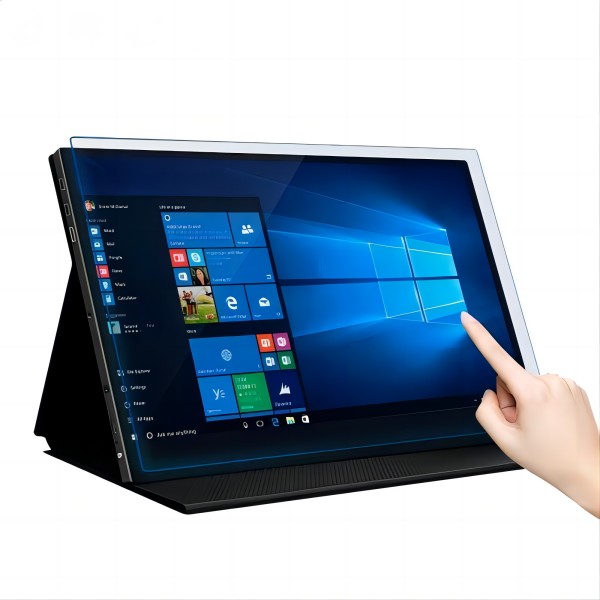Düğmelerin ve Klavyelerin Ötesinde: Ekran Etkileşim Teknolojisinin Kalıcı Etkisi
Teknolojiyle etkileşim kurma şeklimiz uzun bir yol kat etti. Hantal klavyelerin ve kafa karıştırıcı düğme düzenlerinin olduğu günler geride kaldı. Bugün, çok daha sezgisel ve kullanıcı dostu bir yöntem hüküm sürüyor: genellikle dokunmatik ekranlar olarak adlandırılan ekran etkileşim teknolojisi.
Bu makale, ekran etkileşim teknolojisinin büyüleyici dünyasına girerek geçmişini, çeşitli uygulamalarını ve heyecan verici geleceğini araştırıyor.

Ekran Etkileşiminin Kısa Tarihi: Dirençli Başlangıçlardan Gelişmiş Algılamaya
Ekran etkileşim teknolojisinin icadı, Amerikalı bilim adamı E.A. Johnson tarafından ilk dokunmatik ekranın yaratılmasıyla 1960'lara kadar uzanmaktadır. Bu öncü tasarımda bir cam panel ve iletken bir film kullanılmıştı. Bir kullanıcı ekrana dokunduğunda, film deforme oluyor ve elektrik direncinde dokunuşun yerini belirleyen bir değişikliğe neden oluyordu.
O ilk günlerden bu yana, ekran etkileşim teknolojisi önemli ilerlemeler kaydetti. 1970'lerde kapasitif dokunmatik ekranlar ortaya çıkarken, 1980'lerde kızılötesi teknolojisi kullanılmaya başlandı. 1990'larda yüzey akustik dalga dokunmatik ekranlar ortaya çıktı ve 2000'lerde optik görüntüleme dokunmatik ekranlar dönemi başladı.
Akıllı Telefonlardan Otomatlara: Ekran Etkileşiminin Yaygın Kullanımı
Ekran etkileşim teknolojisi, çok çeşitli elektronik cihazlara sorunsuz bir şekilde entegre edilerek günlük hayatımızın vazgeçilmez bir parçası haline gelmiştir. İşte öne çıkan bazı örnekler:
-
Mobil Cihazlar: Akıllı telefonlar ve tabletler büyük ölçüde ekran etkileşimine dayanır ve kullanıcıların basit dokunuşlarla uygulamalarda gezinmesine, seçenekleri seçmesine ve içerikle etkileşime girmesine olanak tanır.
-
Dizüstü bilgisayarlar: Birçok dizüstü bilgisayarda bulunan dokunmatik ekranlar, kullanıcılara geleneksel klavye ve trackpad'in ötesinde alternatif bir giriş yöntemi sunuyor.
-
Otomatlar: Modern otomatlar genellikle dokunmatik ekranlar kullanır ve ürün seçmek ve satın almak için kullanıcı dostu bir arayüz sağlar.
-
Bilgi Kioskları: Kamusal alanlarda her yerde bulunan dokunmatik ekranlı kiosklar, kolayca erişilebilen bilgi alma ve self servis işlevleri sunar.
-
Temellerin Ötesinde: Ekran etkileşim teknolojisi bu yaygın örneklerin ötesine geçerek tıbbi cihazlarda, endüstriyel kontrol ekipmanlarında, araç navigasyon sistemlerinde ve daha birçok alanda uygulama alanı bulmaktadır.
Geleceğe Bir Bakış: Ekran Etkileşiminin Devam Eden Evrimi
Ekran etkileşim teknolojisinin geleceği olasılıklarla dolup taşıyor. Teknoloji gelişmeye devam ettikçe, gelişmiş işlevlere sahip daha hassas, doğru ve dayanıklı dokunmatik ekranlar bekleyebiliriz. Bu, daha geniş bir uygulama yelpazesine yol açabilir ve insanların teknolojiyle etkileşim kurma biçiminde daha fazla devrim yaratabilir.
Akıllı ev cihazlarını bir dokunuşla sorunsuz bir şekilde kontrol ettiğinizi veya bir ekrandaki sezgisel hareketlerle artırılmış gerçeklik deneyimleriyle etkileşime girdiğinizi hayal edin. Olasılıklar gerçekten sonsuz.
Ekran Etkileşim Teknolojisi: Sıkça Sorulan Sorular
S: Ekran etkileşim teknolojilerinin farklı türleri nelerdir?
C: Dirençli, kapasitif, kızılötesi, yüzey akustik dalga ve optik görüntüleme dokunmatik ekranları dahil olmak üzere çeşitli türleri vardır. Her biri farklı algılama prensiplerine göre çalışır.
S: Ekran etkileşim teknolojisini kullanmanın avantajları nelerdir?
C: Ekran etkileşim teknolojisi, düğmeler ve klavyeler gibi geleneksel giriş yöntemlerine kıyasla daha sezgisel ve kullanıcı dostu bir deneyim sunar. Ayrıca yerden tasarruf sağlar ve daha temiz ve daha modern bir cihaz tasarımına olanak tanır.
S: Ekran etkileşim teknolojisi nasıl gelişmeye devam edecek?
C: Hareket tanıma gibi yeni özelliklerin entegrasyonunun yanı sıra dokunma hassasiyeti, doğruluk ve dayanıklılıkta ilerlemeler bekleyebiliriz.
Sonuç olarak, genellikle dokunmatik ekranlar olarak adlandırılan ekran etkileşim teknolojisi, insan-bilgisayar etkileşimini temelden dönüştürmüştür. Mütevazı başlangıcından çeşitli cihazlarda yaygın olarak benimsenmesine kadar, bu teknoloji gelişmeye devam ediyor ve dijital dünyayla etkileşim kurma şeklimizi şekillendiriyor. Geleceğe baktığımızda, olasılıklar heyecan verici olmaya devam ediyor ve dokunmanın gücüyle teknolojiyle etkileşim kurmanın daha da sorunsuz ve sezgisel yollarını vaat ediyor.
